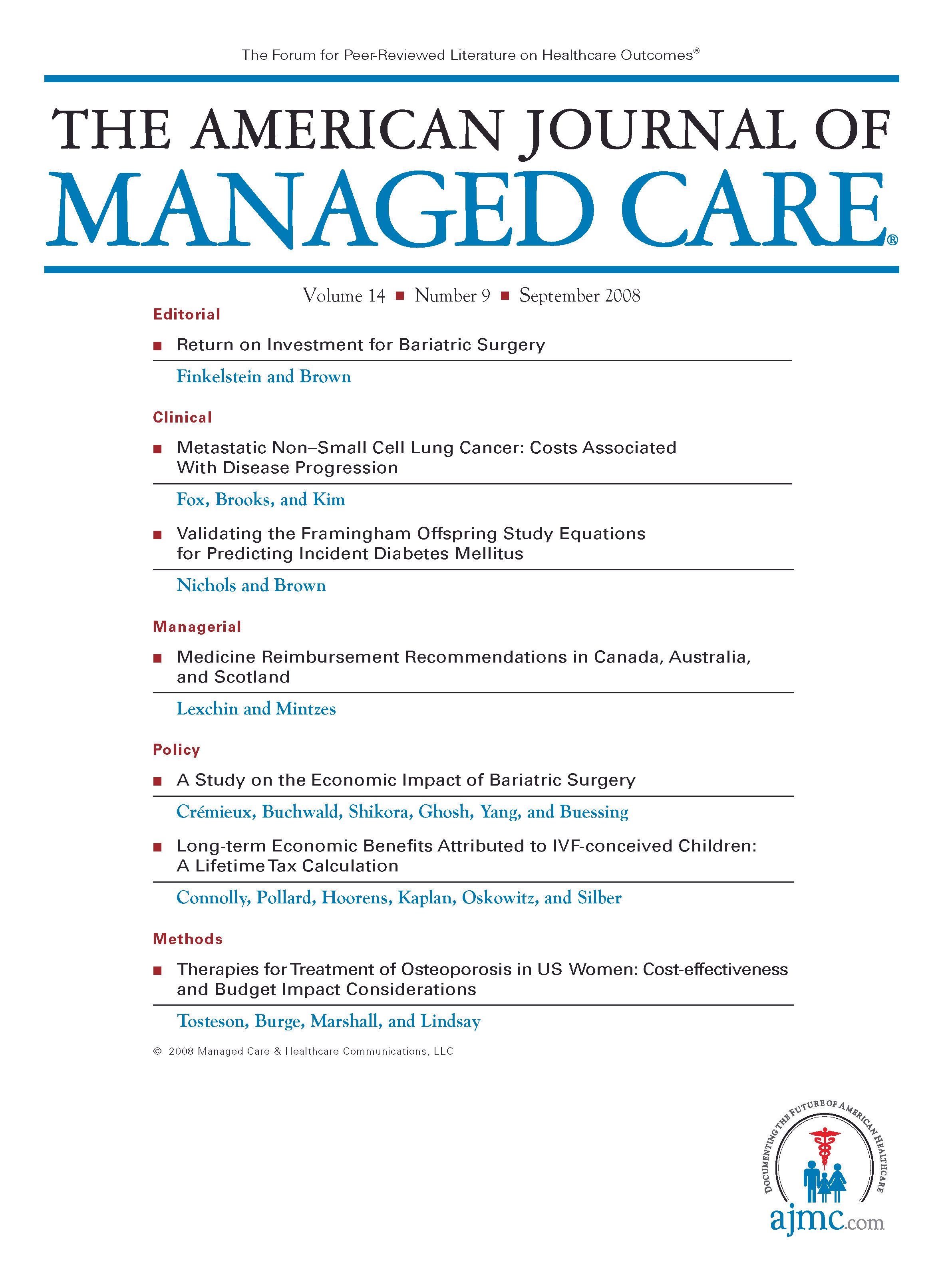Publication
Article
The American Journal of Managed Care
Complementary and Alternative Medicine in Cancer Care
Author(s):
To the Editor:
In the May 2008 issue, I read with interest the article by Lafferty et al regarding complementary and alternative medicine (CAM) use among cancer patients under mandatory insurance coverage.1 It is unfortunate that the authors did not have access to data regarding CAM sought by terminally ill patients that was outside insurance coverage; the article raises an important issue about the ethics of offering certain CAM therapies.
When I was a medical student a number of years ago, I rotated through the clinic of a well-known alternative practitioner who offered week-long programs for the terminally ill that included herbal oil massages, foods thought to contain salubrious amounts of the Ayurvedic humors (vata, pitta, and kapha), and meditation. The program was oriented more toward cure from Ayurvedic practice than palliation, I found. Although there are undoubtedly many benefits to be derived from such engagement in spiritual endeavors, these programs cost many, many thousands of dollars, of which insurance covered zero, and seemed to be populated by those whom conventional medicine had failed—those willing to spend anything in desperate, final, and ultimately futile hope of a miraculous cure for their cancer. The practitioner has become a very, very rich man.
The terminally ill are a vulnerable population and more likely to be willing to spend money on unproven therapies because of their desperation. Managed care must be judicious in its coverage of CAM therapies, carefully evaluating the costs, potential benefits for the patients, and risks in light of this desperation. Additionally, managed care organizations that do offer CAM have a responsibility to educate their patients on the actual evidence that exists for benefiting the patient, and brokering reasonable expectations about healing, cure, and palliation.
Christopher N. Mills, MD, MPH
Department of Emergency Medicine
George Washington University
Washington, DC
Funding: None reported.
Author Disclosure: The author reports no relationship or financial interest with any entity that would pose a conflict of interest with the subject matter of this article.
Address correspondence to: Christopher N. Mills, MD, MPH, Department of Emergency Medicine, George Washington University, 2150 Pennsylvania Ave, NW-Ste 28-417, Washington, DC 20037. E-mail: cnmills@yahoo.com.
Reference
1. Lafferty WE, Tyree PT, Devlin SM, Andersen MR, Diehr PK. Complementary and alternative medicine provider use and expenditures by cancer treatment phase. Am J Manag Care. 2008;14(5):326-334.
In Reply:
We thank Dr Mills for the feedback on our article and appreciate the opportunity to respond to his comments. Washington State law applies only to licensed complementary and alternative medicine (CAM) providers.1 These practitioners have had up to 4 years (and in many cases more) of training by accredited CAM professional schools. In addition, CAM must always be integrated with conventional care for cancer therapies based on the regulations for scope of practice.2
The anecdote you describe about potential CAM misuse (promising cure instead of palliation) would not likely occur under the insurance model of CAM reimbursement in Washington State since the eligible providers are regulated and paid as appropriate. Integrating CAM providers into a cancer care team probably increases the focus on approved services and the use of approved providers. The end result is probably better quality and a lower potential for CAM misuse. Additionally, we did not find the cost of CAM care to be prohibitive from an insurer point of view; only 0.1% of healthcare expenditures in the end-of-life phase were attributed to the utilization of CAM.3
With that said, many conventional healthcare practitioners have been shown to overuse medical care, especially for patients at the end of life.4 Pharmaceutical treatments are broadly marketed directly to consumers; off-label use of pharmaceuticals in the absence of clear indications is common5; and ineffective and very toxic forms of conventional care (eg, bone marrow transplant for stage IV breast cancer)6 have been integrated into conventional care faster than these treatments can be proven to be ineffective in a clinical setting.
Thus, improving overall care quality, conducting comparative effectiveness studies, and weeding out all types of useless treatment—CAM and conventional—is an important goal for healthcare reform.
William E. Lafferty, MDDepartment of Health Services
School of Public Health and Community Medicine
University of Washington
Seattle, WA
M. Robyn Andersen, PhD, MPHTranslational Outcomes Research Group
Fred Hutchinson Cancer Research Center
Seattle, WA
Department of Health Services
School of Public Health and Community Medicine
University of Washington
Seattle, WA
Funding: This study was supported by grant NIH-5 R01AT003270 from the National Center for Complementary and Alternative Medicine. Its contents are solely the responsibility of the authors and do not necessarily represent the official views of the National Center for Complementary and Alternative Medicine or the National Institutes of Health.
Author Disclosures: The authors (WEL, MRA) report no relationship or financial interest with any entity that would pose a conflict of interest with the subject matter of this reply.
Address correspondence to: William E. Lafferty, MD, Department of Health Services, School of Public Health and Community Medicine, University of Washington, Box 357660, Seattle, WA 98195. E-mail: billlaf@u.washington.edu.
1. Washington State Law Committee. Health plan requirements. Wash Rev Code. §48.43.045 (1995).
2. Washington State Office of the Insurance Commissioner. Issues in coverage for complementary and alternative medicine services: report of the clinical workgroup on the integration of complementary and alternative medicine. Olympia, WA; January 2000.
3. Lafferty WE, Tyree PT, Devlin SM, Andersen MR, Diehr PK. Complementary and alternative medicine provider use and expenditures by cancer treatment phase. Am J Manag Care. 2008;14(5):326-334.
4. Sharma G, Freeman J, Zhang D, Goodwin JS. Trends in end-of-life ICU use among older adults with advanced lung cancer. Chest. 2008;133(1):72-78.
5. Radley DC, Finkelstein SN, Stafford RS. Off-label prescribing among office-based physicians. Arch Intern Med. 2006;166(9):1021-1026.
6. Deyo RA, Patrick DL. Hope or Hype: The Obsession with Medical Advances and the High Cost of False Promises. 1st ed. New York: AMACOM; 2005.


